
14 minute read
California’s Flora: A Natural Solution for a Changing Climate
By: Scot Pipkin, Director of Education and Engagement
On the southern flank of the Tehachapi Mountains, there is a ridge that overlooks the Antelope Valley. Like its neighbors, this ridge runs east to west, before turning and rising to the southernmost reaches of the Sierra Nevada. Unlike its neighbors, this particular ridge is home to a small plant community that might not exist anywhere else in the world. Here, one can find three iconic California species all growing within a few yards of each other: valley oak (Quercus lobata), blue oak (Quercus douglasii), and Joshua tree (Yucca brevifolia). While the two oaks can often be found growing alongside one another in the foothills that create a ring around California’s great central valley, mixing in the Joshua tree, one of the great ambassadors of the Mojave Desert, is pretty unique (figure 1).

If one were to ascend this ridge, all the way to its crest, they would find themselves standing at the interface of a block of limestone — ancient marine sediments thrust upward to a height of 6,000 feet (1,828 meters) above today’s sea level — and the granitic rocks more typical of the Sierra Nevada. On these out-of-place substrates, another curious plant community emerges. Here, plants specialized to live in much more specific conditions can be found, including pine green gentian (Frasera neglecta; figure 2), a plant endemic to Southern California’s Transverse Ranges and a small corner of the Sierra Nevada. These limestone roof pendants are also home to the Tehachapi buckwheat (Eriogonum callistum), a recently discovered species that is only known to occur in these limestone soils and nowhere else on Earth.
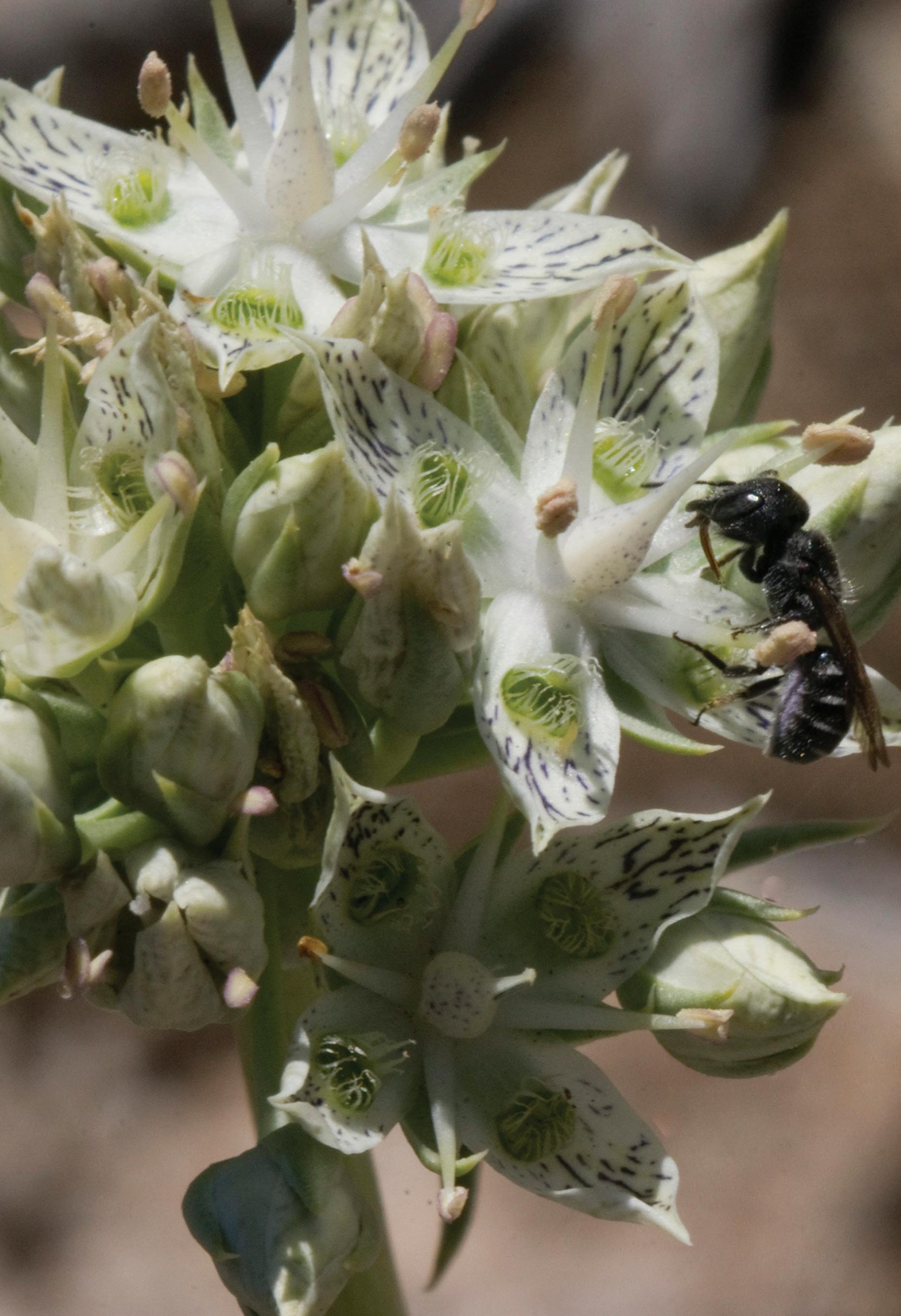
In some ways, this ridge is just a tiny blip in the story of California’s flora. It’s a relatively small area that yields to more typical vegetation on all sides — rubber rabbit brush (Ericameria nauseosa) and saltbush (Atriplex spp.) in the lower elevations and white fir (Abies concolor), canyon live oak (Quercus chrysolepis), and great basin sagebrush (Artemisia tridentata) up higher. However, this spot, at the cusp of such geographic drama — the great Mojave Desert, the Sierra Nevada, the Central Valley, and even some influence from the Pacific Coast — is emblematic of larger forces at play. Here, we get a glimpse at the impressive geography that has incubated some of the most celebrated biological diversity on Earth.
Why Biodiversity Matters
Recounting California’s geographic prowess and extolling the conditions that support North America’s most diverse flora isn’t purely a navel-gazing exercise. These features directly contribute to why California is home to so much life. Each species, subspecies, or other wild population can be imagined as a solution to a puzzle: how to survive under a set of biotic and abiotic conditions. We can look at each species thriving, surviving, or hanging on in each location as a potential model for how we as humans can continue to inhabit this land.
Since time immemorial, humans have recognized the healing powers that plants provide. For most of our history as a species, medicine has come directly from plant sources. In many cases, this is because plants have developed chemical adaptations to reduce herbivory and combat fungi, viruses, and bacteria. When we drink tea or take an extract of these plants, we ingest various terpenes and other chemicals, which help us stave off infection and relieve acute symptoms such as a headache. For the last several centuries, ethnobotanists and other western scientists have scoured the globe in search of plants and other organisms that provide lifesaving medicines. Indigenous people have known about these medicines and more since the time of the stories that teach how to collect and process.
In our current age of climate upheaval, we can also turn to the astounding diversity of life to provide models for how we might continue to survive on a planet whose climate is becoming increasingly unpredictable. As human actions have accelerated and exacerbated the systems that moderate our climate, life that has been able to gradually adapt to more subtle shifts over millennia is put in a predicament. Plants are particularly vulnerable to these rapidly changing conditions. Warmer temperatures may trigger early flowering or entice pollinators to emerge before flowers have developed. These mismatches in timing can have catastrophic effects on fruiting, seed set, and reproduction for plants. If the timing of such processes becomes out of sync over years or decades, plants may struggle to survive.
Observing Nature To Help Our Communities
Not far from where the oaks and Joshua trees meet, an enthusiast of acorns would be able to find a particular shrubby tree, Alvord’s oak (Quercus x alvordiana). This interesting plant, which can either be evergreen or deciduous, grows in the dry regions of Monterey, San Benito, Kern, and Los Angeles counties. What if this tree, a hybrid between blue oak and one of either Tucker’s oak (Q. john-tuckeri) or turbinella oak (Q. turbinella), could prove to be an attractive landscaping plant for those who want an oak in their yard but don’t have space (or the right climate) to support a plant with a 50-foot (15-meter) spread? Maybe this is just the right plant for those looking for “climate-forward” choices that provide all the habitat-creating effects of an oak alongside reliable performance in a hotter, drier world. While it may be far-fetched to think that a somewhat obscure hybrid oak will be the key to landscaping with native plants during the climate crisis, Alvord’s oak is an illustration of how California’s rich floristic biodiversity may yet hold the secrets to building habitat in our communities as the sands of climate shift under our feet.
Closer to home, Santa Barbara Botanic Garden is considering how other members of the oak genus (Quercus spp.) might be viable solutions as native street trees. Oaks that perform well in ever-hotter urban conditions would be a huge asset, keeping in mind that species used as street trees need to have a natural upright growth form with a single main stem, can take pruning, and are able to grow in somewhat tight spaces.
If you walk to the southeastern corner of the Meadow Section of the Garden, you will find a magnificent Englemann oak (Quercus engelmannii), a species that largely grows in San Diego County and into Baja California, Mexico, but also has populations as far north as Pasadena (figure 3). This tree has successfully been planted in places like the Apple campus in Cupertino. We are also looking at successful plantings of the island oak (Quercus tomentella) in locations along the new multiuse path at Las Positas as indications that this tree might become a workhorse native tree for urban areas across our region. Taking a creative look at all of the tools in our floristic toolbelt is important to achieve the vision of healthy and vibrant communities where people, plants, and the web of life thrive.
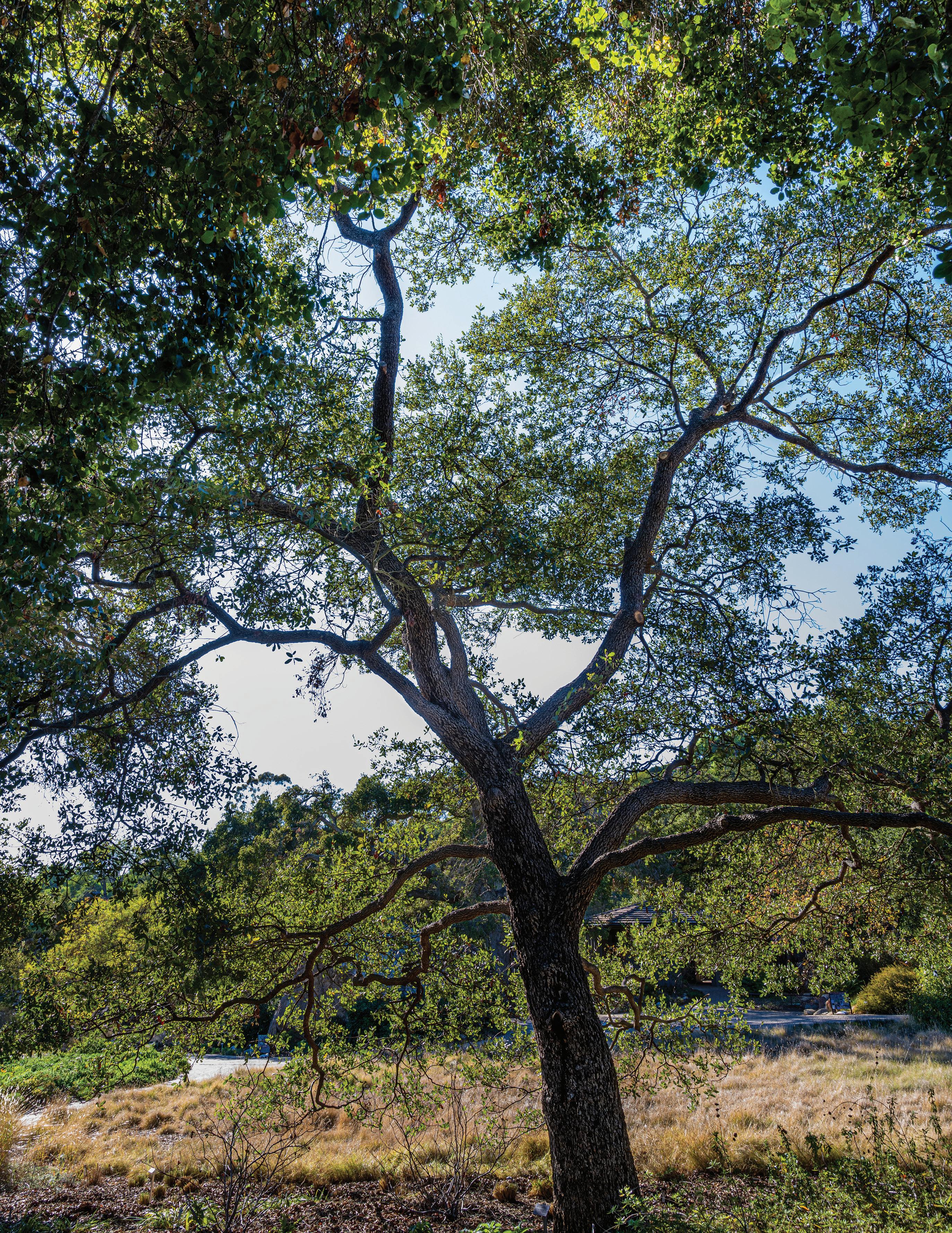
Bringing Biodiversity Back Home
There are many ways, as the saying sometimes goes, to peel an orange. This holds true for bringing biodiversity back into our yards and communities. However, there are a few rules of thumb that can be employed to help us along the way. First, it’s important to remember that planting for biodiversity doesn’t simply mean acquiring as many kinds of plants as we can and putting them in the ground. While that is a surefire way to achieve a richness of plant species, it doesn’t achieve the objective of providing lush, nourishing habitat for an abundance of wildlife.
A single hummingbird sage (Salvia spathacea) planted next to coral bells (Heuchera sp.), goldenrod (Solidago sp.), and a solitary narrow-leaved milkweed (Asclepias fascicularis) aren’t likely to do a whole lot for supporting wildlife. Particularly if your space is limited, consider selecting a smaller number of overall species and massing them into blocks of habitat through mass planting. This will ensure that your yard is supporting populations of invertebrates, birds, and other wildlife, not just individuals.
Of course, the provision of habitat is always mitigated by which species you have selected. A single coast live oak (Quercus agrifolia) tree will provide an abundance of habitat over its lifetime. Even a single smaller shrub, such as a well-placed buckwheat (Eriogonum spp.) can provide a massive boost to the habitat quality of your yard.
In addition to massing habitat plants in blocks to ensure that your design supports whole populations of organisms, especially invertebrates, it’s important to think about the 3D structure of your design. We know that certain pollinators are attracted to certain kinds of flowers based on color, shape, odor, etc. Similarly, invertebrates, birds, frogs, salamanders, and others have certain structural requirements they are looking for in a habitat. Birds in particular make use of many different parts of a habitat, ranging from the tree canopy to the ground (figure 4). Maximizing the structural diversity of your design will help provide the various micro-habitats that will support diverse avifauna. If possible, try to use plant species that will provide an overhead canopy above 10 to 15 feet (3 to 4.5 meters), a shrub layer beneath that, and some number of subshrubs and/or groundcovers low to the ground. Not only will these plants provide food and foraging habitat, but they will also help create a rich light-scape, where sunlight and shadows interplay to offer hiding spaces, branches to sing from, and shelter for reproductive structures (nests, egg sacks, shelter for young, etc.).
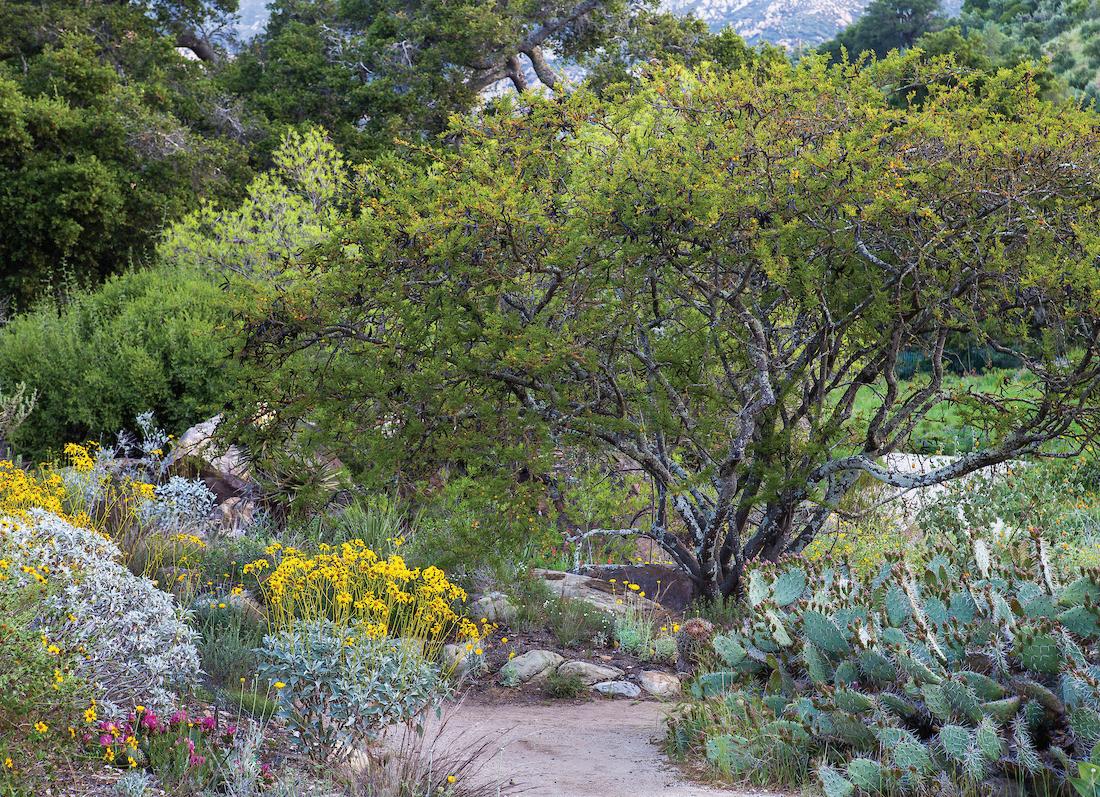
Adding seasonal diversity to your landscape can be another important way to ensure that the plants you install are doing the most to support local ecosystems. California’s Mediterranean climate means that plants will flower just about every month of the year. By planning your garden’s calendar to ensure that flowers and fruits are constantly available for wildlife, you are not only doing a good turn for biodiversity, but you’re also making your garden a more delectable place for people.
There are also abiotic decisions you can make to support biodiversity in your yard or neighborhood. A source of clean water is always a welcome feature for almost all wildlife. Being mindful of your ground surface can also help biodiversity. Ensuring pathways are permeable allows water to absorb into the ground and supports healthy subterranean communities that will improve soil quality and growing conditions for your plants. Access to the soil can be a major benefit for organisms such as native bees, many of whom actually nest in cavities dug into the earth.
Six Native Plants To Boost Biodiversity
Although the over 6,000 taxa of native California plants are not all available as landscape choices for residents, there is quite a palette of native species that we can add to our yards and neighborhoods to grow biodiversity. While the stalwart oaks, sages (Salvia spp.), toyon (Heteromeles arbutifolia), manzanita (Arctostaphylos spp.), and Ceanothus are fantastic plants for supporting species-rich communities, we can augment the most widely available California native plants with other species that can be found in the nursery trade.
Bladderpod (Peritoma arborea)
This small-to-medium shrub is tough and can bloom vigorously. A member of the caper family, bladderpod (figure 5) has expressive yellow blooms that attract a variety of pollinators. Coupled with its compound leaves displaying three silvery leaflets, this plant has a lot of attractive features. Bladderpod works hard in the wild, creating habitat in some of California’s harshest environments. I think it deserves a little pampering in our neighborhoods.
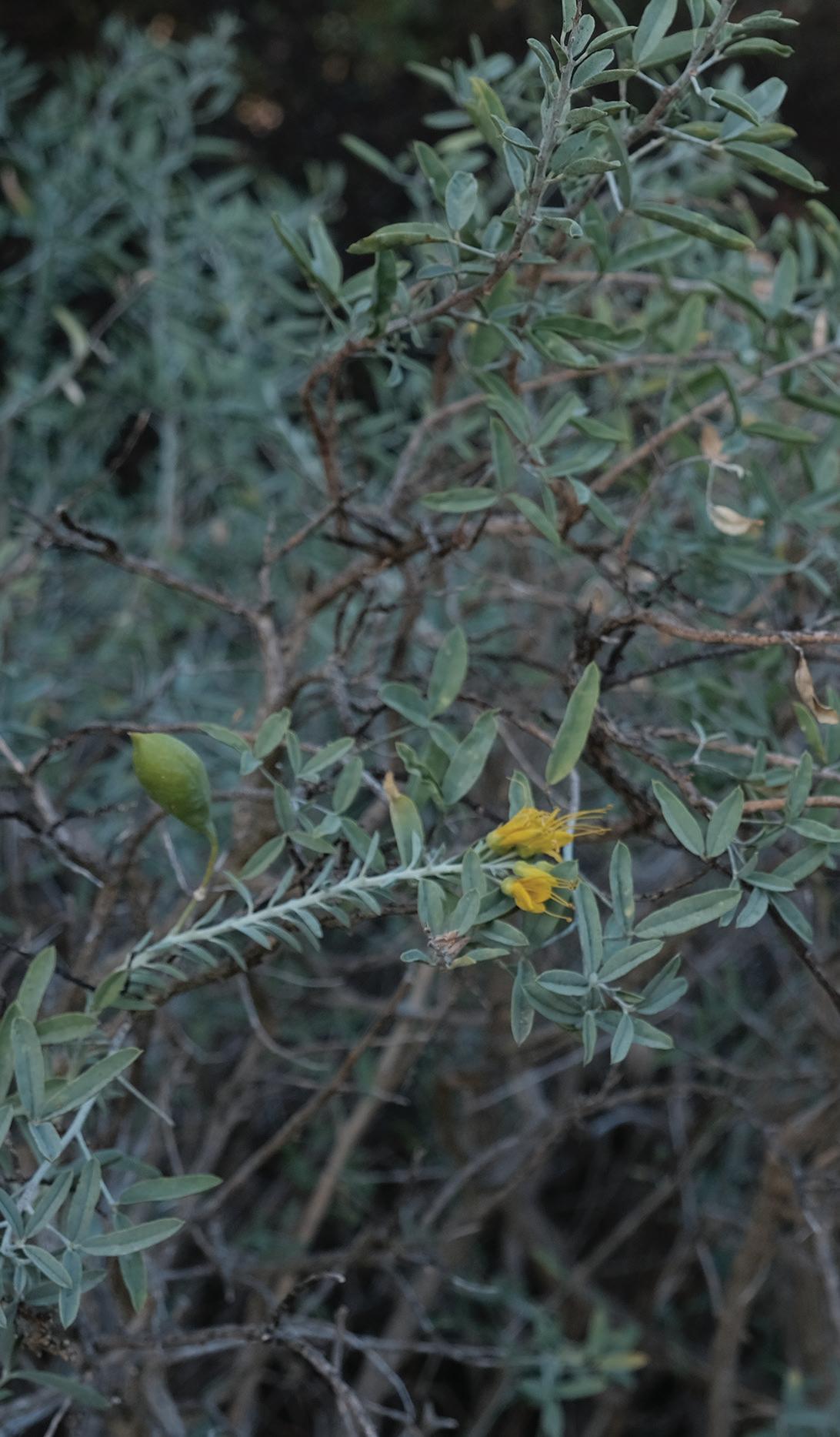
Elderberry (Sambucus mexicana)
This small tree is a great choice if you have a mulched basin or location where water collects. While elderberry trees (figure 6) can do just fine with little water once established, it’s not a bad idea to provide a little extra water initially. Once established, an elderberry provides habitat, medicine, musical instruments, and beauty. When left alone, they can grow in a wild, multi-stemmed shape that wildlife love. With a bit of grooming, this plant is a living sculpture. Know that elderberry can be toxic if handled incorrectly. Consult a trusted resource before processing. Hint: the Garden Shop has several relevant books available.
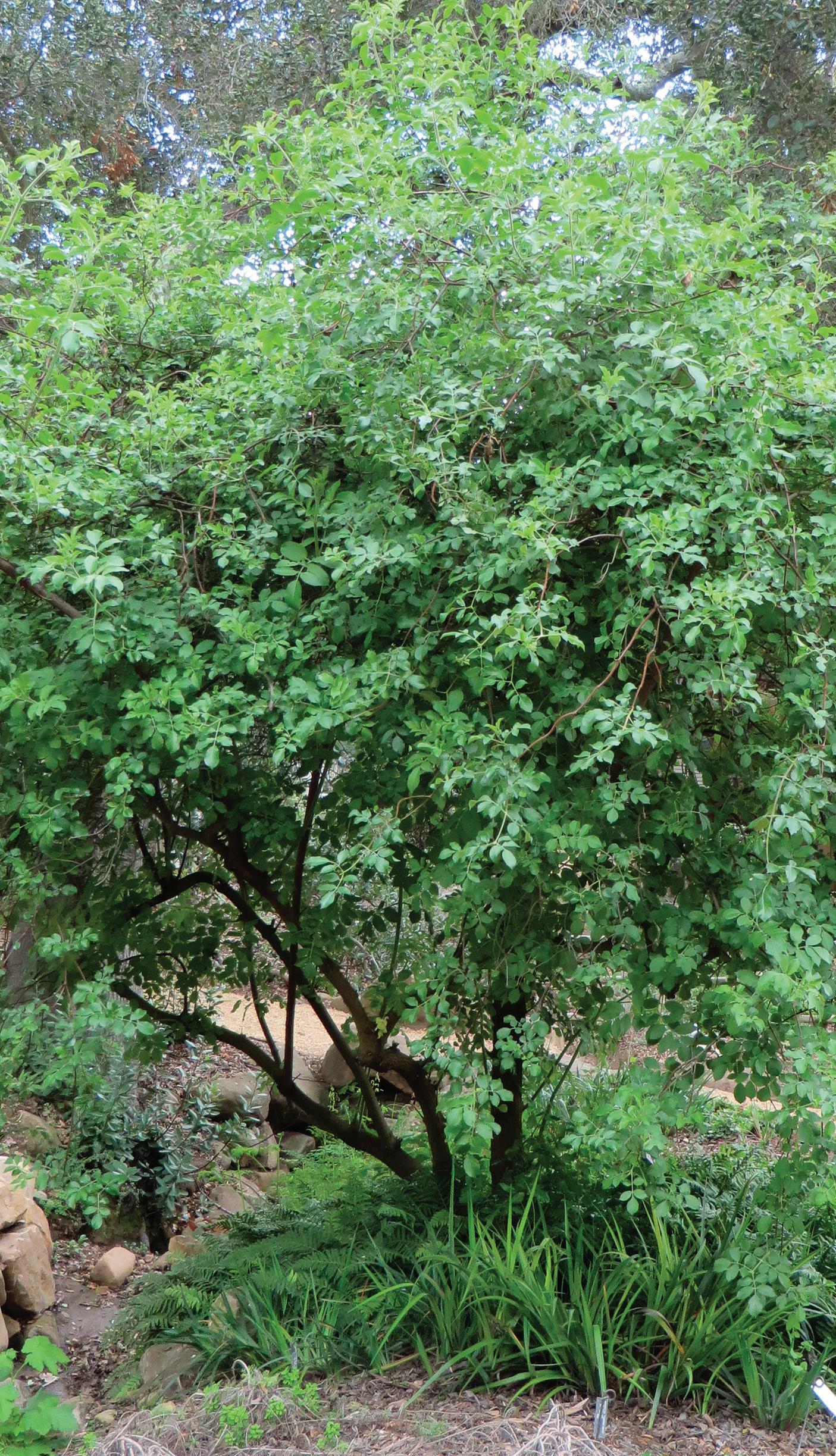
Yerba Santa (Eriodictyon californicum)
This tough shrub has fragrant, leathery leaves and beautiful purple flowers in late spring. Yerba santa (figure 7) grows by rhizome, so once established, it can spread. For those interested in growing their own medicine, this plant is a powerful and much-celebrated treatment for a number of respiratory conditions. Minimal time spent searching “Eriodictyon yerba santa” on Google Scholar yielded this nugget: frontiersin.org/articles/10.3389/fphar. 2020.00208/full.
Shout out to herbaria for helping ensure people can try a study like that. Remember to consult trusted resources when making medicine. Stay tuned for some upcoming classes and other content to help you grow your own.

Catalina Cherry (Prunus ilicifolia ssp. lyonii)
Though not necessarily a “sleeper” choice, the attractive Catalina cherry tree (figure 8) continues to impress. It's not the best street tree due to the red stain fruits will leave on concrete, but one of these in the backyard or a sloped area can be a bird-watcher’s delight. Plant nerd as I am, I do love just being around the Genus Prunus, which yields so many of my favorite fruits.
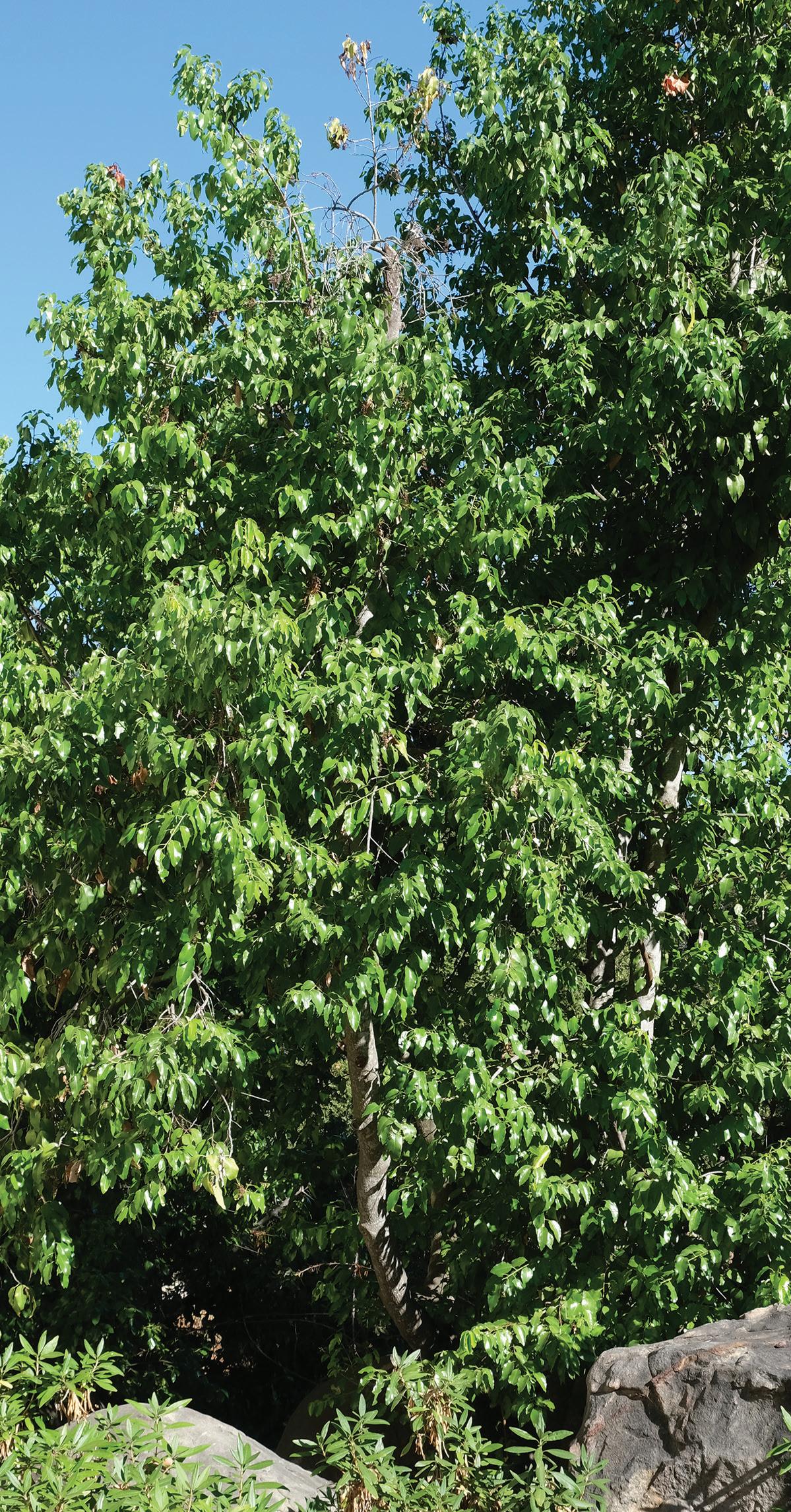
California Aster (Corethrogyne filaginifolia)
This low-growing perennial can create a carpet of purple florets that the insects crave. Once established, don’t try to water this plant much. Like the bladderpod, this is quite a tough plant. The California aster (figure 9) is a great choice if you have rocky soil or some topography to creep and cascade over.
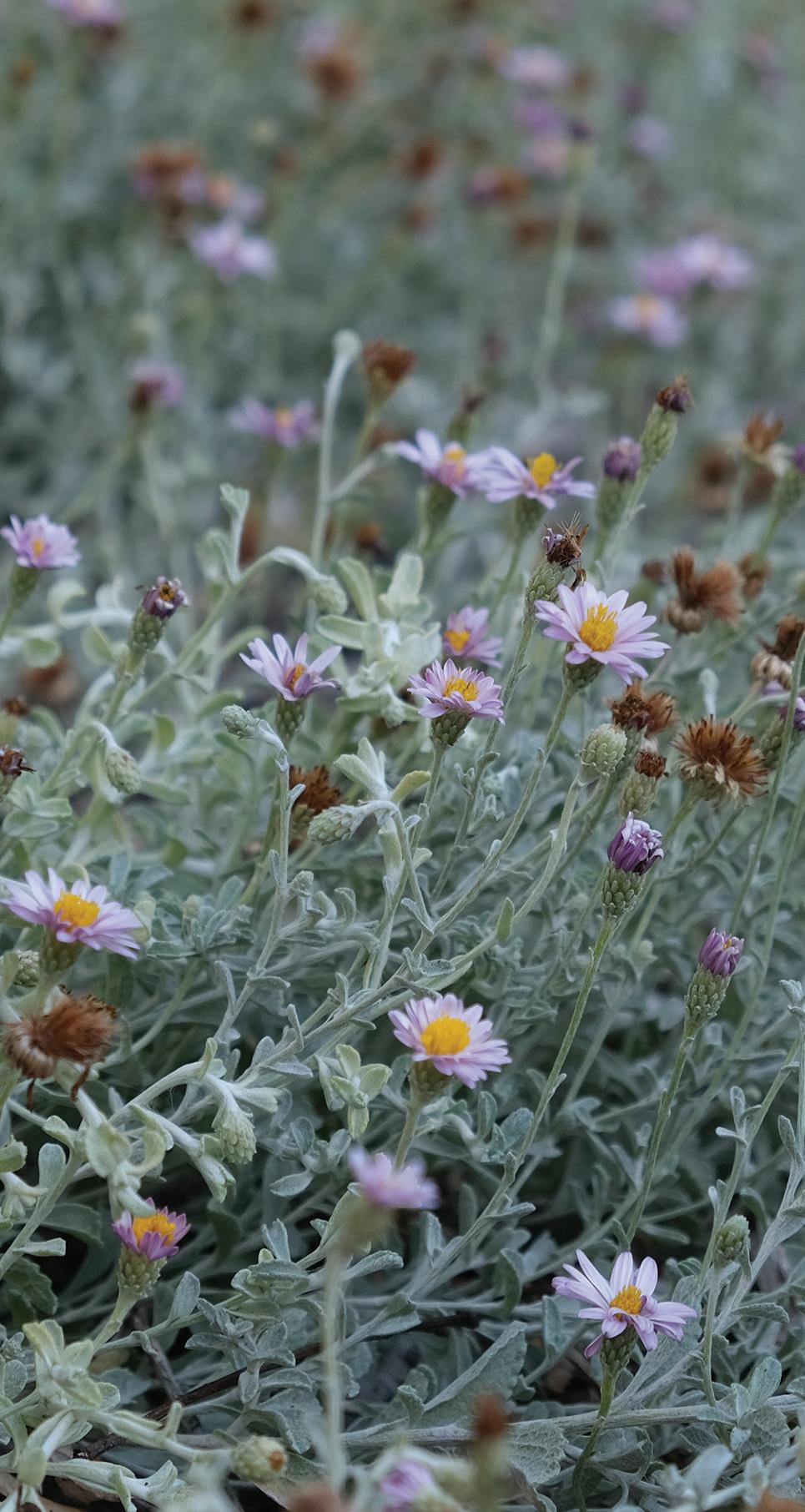
Chaparral Mallow (Malacothamnus fasciculatus)
This honorable mention is a spreading, upright plant that has attractive foliage and can proliferate lavender flowers that bees love. The chaparral mallow (figure 10) is not as widely available in the nursery trade as some of the other plants (hence the honorable mention), but like the aforementioned yerba santa and the celebrated Matilija poppies (Romneya spp.), this is a plant that spreads via rhizome. Once established, it can take over, so just know before you grow.
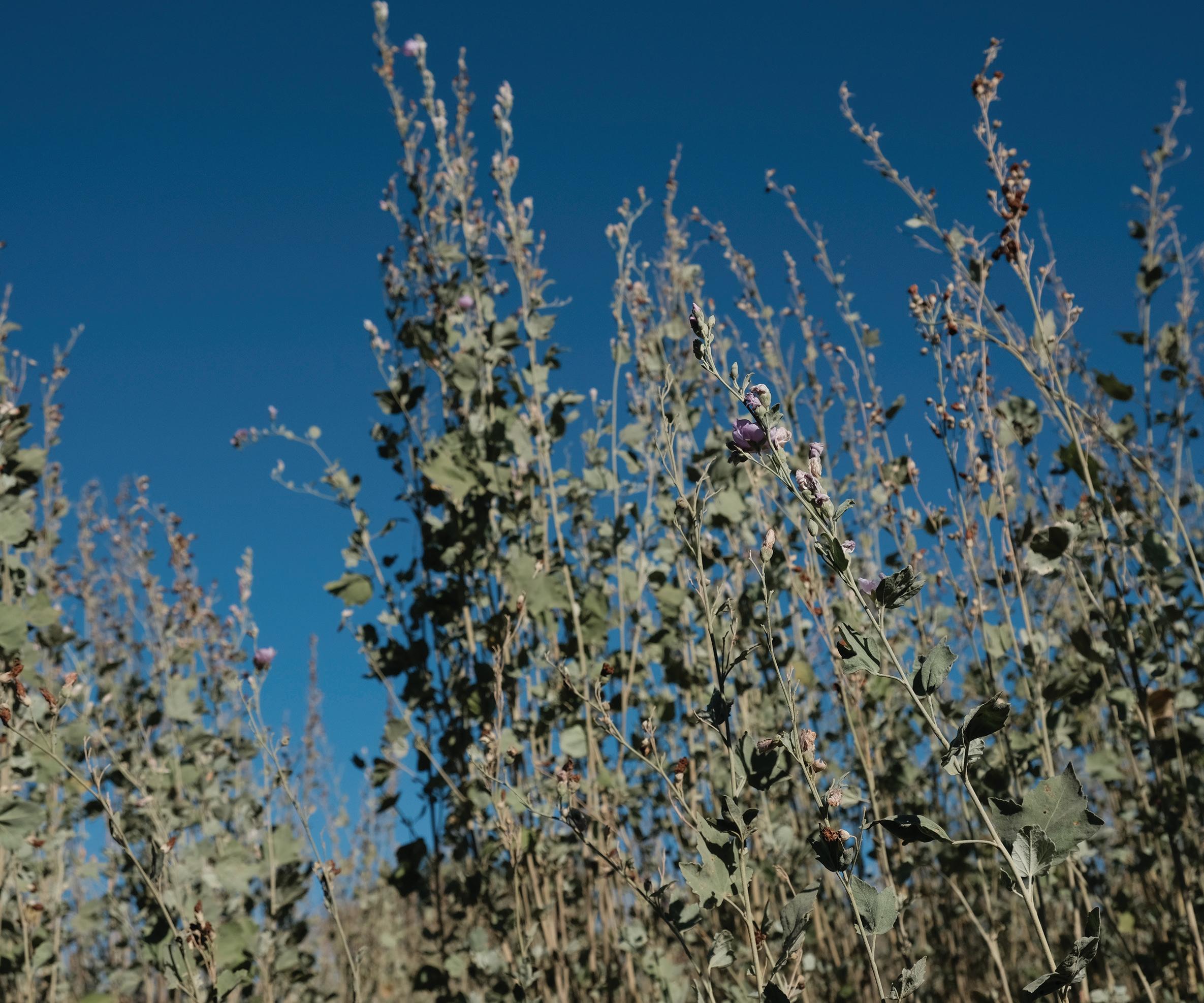
Slow Down, Connect, and Enjoy
The gift of life, we’re told, is something to cherish and celebrate. Often, this is said in the context of our own lives, encouraging words to inspire deeper personal joy and appreciation for our cognitive and physical resources as humans. While I completely agree with this sentiment, it strikes me that we can also think about the gift of life as it manifests in all the forms around us — animal, vegetable, mycological — and the inspiration and comfort we can derive from playing a small part in the perpetuation of life on Earth. Growing biodiversity allows us to tap into this larger celebration. By viewing our gardens as pockets of biodiversity, we connect with forces that are at the same time ancient and novel, spiritual and scientific.
In California, gardening for biodiversity is also a reminder to celebrate the rich, diverse landscape we get to call home. I wish everyone reading this the joy of discovering an exquisite organism living in their garden, attracted to the celebration of life that native plants bring.










